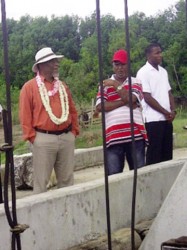Mahaicony farmers complained that they continue to be hampered by seasonal flooding and they need help to rehabilitate the koker and stelling, when Prime Minister Samuel Hinds toured the Region Five community last week.
Residents told the prime minster that despite lodging several complaints at the drainage and irrigation division, nothing has been done to alleviate their woes, at a meeting hosted by the Central Mahaicony Perth Village Farmers Association. They also said that they need assistance to fix the Mahaicony koker and stelling and land clearing equipment.
According to a Government Information Agency (GINA) report, the prime minister pledged to alert the National Drainage and Irrigation Authority about the flooding problems. He then lauded the progress pig farmers have made since they were last given assistance. The Institute of Private Enterprise Development donated $150,000 to the pig farmers association for the purchase of supplements for the animals and to improve their facilities, GINA said.

In his address, Region Five Chairman Bindrabhan Bisnauth expressed gratitude to the prime minister for visiting the village, and listening to the concerns of farmers and other residents.
“We at the Regional level will continue to give whatever support possible to the group and we’ll like to see the group expand…this part of Region 5 is producing not only for Region 5 but the country and the Caribbean as a whole,” he said. Region Five has produced the highest rice production and for the first crop of 2013, recording 101,262 tonnes, maintaining its stellar performance. In 2012, it produced 150,000 tonnes or 37% of the total production.
The prime minister was accompanied by officials from the Ministry of Agriculture, the National Agricultural Research and Extension Institute and the Guyana Rice Development Board during the tour. The group also visited the stelling, market, koker, police station, the Amerindian Hostel, the Technical and Vocational Training Centre, Diagnostic Centre and several cash crop and livestock farms, during the tour.





